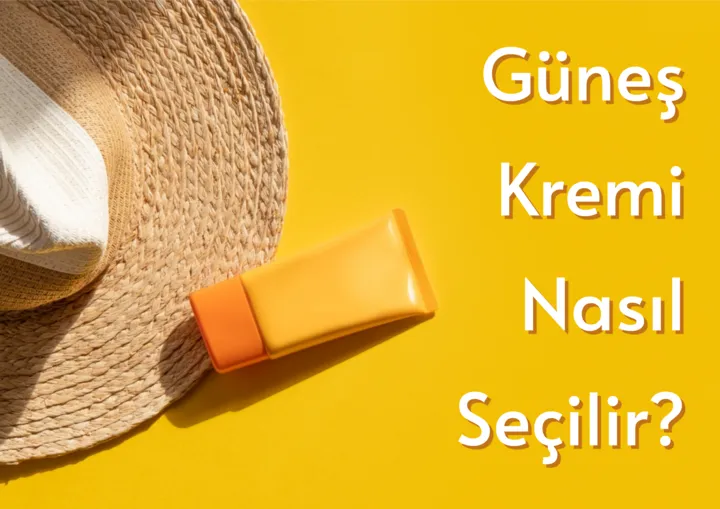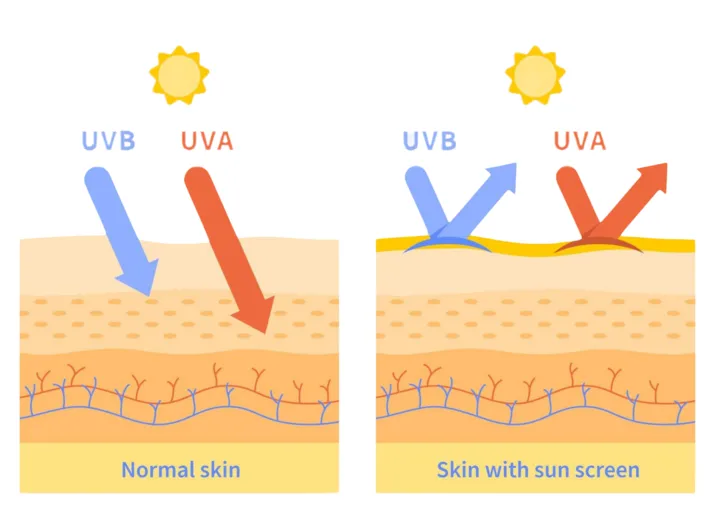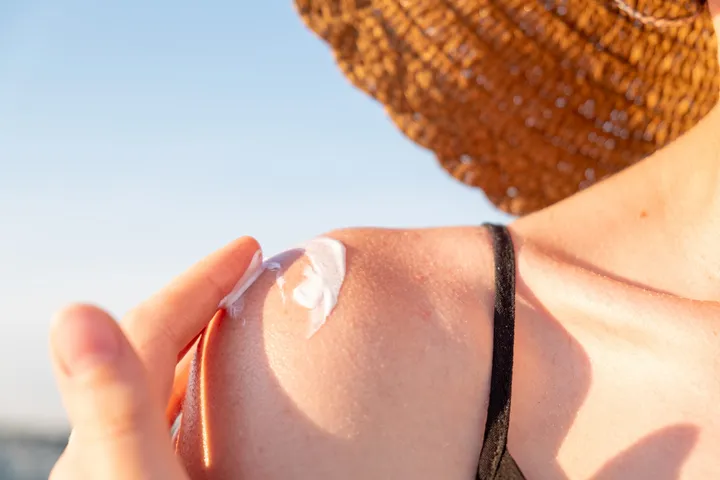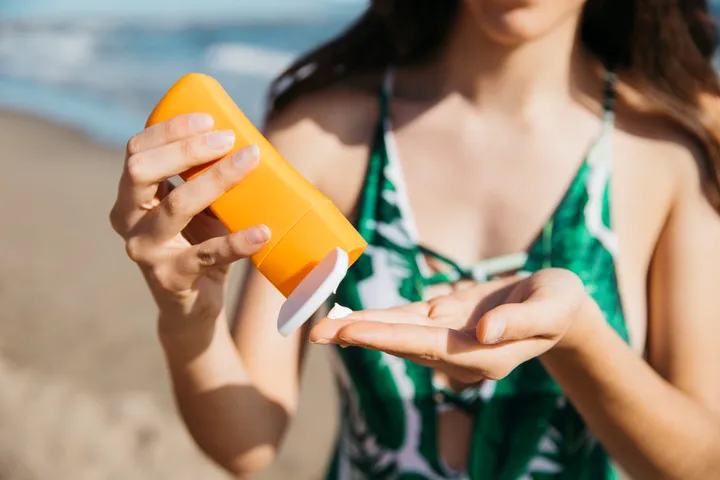How to choose sunscreen?
In the guide we created for your summer vacation, we touched on the details of sunscreen creams according to skin type, product content and protection types.

Although the sun has a structure that warms us with its light and warmth, its rays can be disturbing for our body. Especially in summer, the sun's rays that come into direct contact with the face are also more likely to cause stains and painful burns in certain areas. At this point, sunscreen is one of the heroes that protects the skin from harmful sun rays in direct contact. Sunscreen, which varies according to the protection factor, place of production, filter, skin type, content and brand features, prevents possible problems that may occur on the skin due to the sun. In this way, we can say that creams specially produced with a protective content can be a great savior during the summer season. Today in Campalow, with the summer season open, "How to choose sunscreen?" We have prepared a comprehensive guide on sunscreen creams for those who ask. You can get comprehensive information about the ingredient properties from the production process of the creams and you can be more careful when purchasing. “Which sunscreen should I choose?” If you are looking for a comprehensive answer to your question; Come, let's evaluate together.
How to Choose the Ideal Sunscreen?
How to Choose Sunscreen Based on Radiation Protection?
UV rays that come into direct contact with the skin can be damaging to the basic structure of the skin, as well as a visible stain. Sun-induced ultraviolet rays are divided into different categories according to their wavelengths as UVA, UVB and UVC. UVC rays from this group are prevented from reaching the earth by being filtered by the ozone layer. Therefore, UVA and UVB rays can easily reach the earth.
What are UVA Rays?
The types of rays that reach the earth by passing directly through the ozone layer are called UVA. The said UVA rays; Since it can easily pass through structures such as glass and clouds, it has the ability to affect the lower layer of the skin on human skin. UVA rays can reach the dermis, the middle layer of the skin, and cause skin blemishes. These rays can reveal signs of skin aging in the long run, as well as cause skin reactions. Therefore, it is necessary to use sunscreen cream in order to protect the structure of the skin from UVA rays.
What are UVB Rays?
The types of rays that reach the earth by filtering through the ozone layer at a high rate are also called UVB. The level of filtration of UVB rays from surfaces such as clouds and glass is much lower than UVA rays. UVB rays, on the other hand, help the skin to tan by affecting the epidermis, which is the upper layer of the skin. Therefore, although tanning may seem tempting, the sun's rays that come into direct contact with the skin can reveal all kinds of negative situations, from premature aging to skin cancer. However, the effect of the rays on the skin is transitory. At the same time, the effects of rays may vary according to the season, season and period.

What are UVC Rays?
The type of radiation that is prevented from reaching the earth by being completely filtered by the ozone layer is called UVC. Therefore, since UVC rays are not likely to reach the world directly, there is no effect on the skin layer.
People who want to protect their skin from the harmful rays of the sun often ask, "How many factor sunscreen should I use?" begins to look for a clear answer to his question. At this point, the protective effect of sunscreens is differentiated according to the categories of “SPF, PA, PPD and Broad Spectrum Protection”.
What is SPF Protection?
Users who read the content when choosing sunscreen often ask, “What does 50 SPF mean?” or “What is SPF?” He often wonders about the answers to his questions. The SPF ratio, called "Sun Protection Factor", helps to protect the skin's own structure against UVB rays and has an active role in preventing various skin disorders. SPF rate gives information about the level of protection of the skin from sun rays. The number phrases next to the SPF value can be understood by many users as information about the protection period. However, the number ratios of SPF indicate the level of protection of the product against sun rays. The higher the SPF level of a sunscreen, the higher its level of protection from the sun's rays. In other words, an SPF 30 sunscreen provides stronger protection than an SPF 15 product.
- SPF 15 sunscreen, 93% of UVB rays,
- SPF 30 sunscreen, 97% of UVB rays,
- SPF 50 sunscreen filters 98% of UVB rays.

What is PA Protection?
“How to choose sunscreen?” The PA ratio is one of the concepts that people who are looking for a specific answer to the question about the content are curious about. PA protection, which is called “The Protection Grade of UVA” and means “UVA Protection Factor”, shows the protection level of the product by shading the skin against the harmful rays of the sun. Therefore, the number of plus (+) signs next to PA during sunscreen content reading indicates the protection height, showing the PPD rate. PA protection is listed as follows:
- PPD Ratio: If it is between 2 - 4 values, PA+
- PPD Ratio: If it is between 4 - 8 values, PA ++
- PPD Ratio: If it is between 8 - 16 values, PA +++
- PPD Ratio: For values higher than 16, the phrase PA ++++ is used.
What is PPD Protection?
PPD, which stands for "Persisting Pigment Darkening", is known as "Persistent Pigment Darkening". The PPD rate of a sunscreen is a measure of the time to discoloration of the skin surface, which may or may not be protected from UVA rays. In other words, the PPD ratio, which expresses the duration of protection of the skin from UVA rays, defines the time that UVA rays darken by contacting the skin. Therefore, the number of PPD written on the product means that you can extend the time the skin gets darker and tanned by the number ratio.
For example:
- PPD 10: The tanning time increases 10 times without damaging the skin.
- PPD 5: The tanning time increases 5 times without damaging the skin.
What is Broad Spectrum?
Sunscreen products, where you can see phrases such as "Broad Spectrum Sunscreen" or "Broad Spectrum Protection" in the content of sunscreen, are usually marketed as American origin. Therefore, this ingredient on a cream indicates that the skin is protected against both UVA and UVB rays with a double effect. Therefore, if you want to protect your skin from both UVA and UVB rays of the sun at the same time, you can take a look at the types of creams containing Broad Spectrum text.
What is HEV and IR Ratio?
HEV, or blue light, from the sun can negatively affect the skin's elasticity by inhibiting natural collagen production. For this reason, it is possible to observe wrinkles, dryness, lines and pigmentation problems in skin exposed to blue light. The phrase HEV on the sunscreen indicates the level of protection of the skin against high-energy blue light from the sun.
IR rays, defined as infrared, can cause damage and burns in the skin layer. Therefore, the term IR used on sunscreen is defined as (infrared) and defines the level of blocking of infrared rays coming from the sun towards the skin.
How to Choose Sunscreen According to Filter Separation?

“How should the sunscreen content be?” While researching the question, you may encounter the concepts of physical filter and chemical filter in the product contents specially prepared for sunscreens. At this point, the physical and chemical ratio is related to the distribution ratio of direct sunlight to the skin. The terms physical filter and chemical filter for sunscreens have the following characteristics.
What is a physical filter sunscreen?
Sunscreens consisting of inorganic components are evaluated in the physical filter group. Physical filter protectors scatter the harmful UV rays from the sun directly and help to eliminate the damage that harmful substances will cause on the skin. Titanium dioxide (titanium dioxide) and zinc oxide (zinc oxide) components are seen in the content of the products in question. As two physical (mineral-based) filters approved by the US Food and Drug Administration (FDA) and the European Union (EU), these ingredients also eliminate the level of inflammation in the skin. Due to the large particles in the structure of physical filter sunscreen creams, it is not absorbed by the skin. It also has a reliable effect on the skin as it is non-irritating. Therefore, this makes physical filter sunscreens safe for use by children and pregnant women.
Attention: In sunscreens with physical filters, it is useful to be careful that nanoparticles are not used, the particle size of which is reduced and the level of contact with the skin is increased.
What is sunscreen with chemical filters?
Organic ingredients used in sunscreen creams with chemical filters absorb UVA and UVB rays, helping to prevent the skin from absorbing rays. Chemical sunscreens provide more effective protection against UV rays than products with physical filters. At the same time, the version of chemical filter creams offers a thinner and smoother structure compared to other products. Chemical filter preservatives containing Ethylhexyl Methoxycinnamate, Ethylhexyl Salicylate, oxybenzone (benzophenone-3) and Sulisobenzone (benzophenone-4) do not leave a white mark on the skin. Thus, the skin absorption of the products occurs easily.
Caution: Since the chemical filters in the sunscreen can be absorbed directly from the skin and participate in the circulatory system, they may carry an allergic, toxic reaction and hormonal risk. At this point, products with chemical content are also likely to cause allergy or acne problems on sensitive skin.
How to Choose Sunscreen Based on Its Structure?

“Sunscreen or lotion?” or “Sunscreen or spray?” Questions like this are asked a lot. Therefore, when choosing a good product for sun protection, the structure of the cream and how it will be applied to the skin are also important points to consider. According to their structure, sunscreens are divided into lotion, cream and spray forms.
- Sunscreens: Sunscreens produced in cream form have a more intense and oil-based formula than other types. Therefore, it is recommended that people with dry and normal skin structure use sunscreens produced in cream form.
- Sun Lotions: Sunscreens produced in lotion form have a much more fluid form due to their water-based content. Therefore, it is generally recommended to use sun lotion to meet the water needs of oily skin.
- Sun Sprays: Sunscreens produced in spray form are generally preferred for children due to their easy use. However, spray forms can also have a volatile effect while adhering directly to some parts of the skin. For this reason, it is important to apply the spray by making sure that it forms a layer on the skin.
How to Choose Sunscreen According to Skin Type?

The only purpose of everyone who has not used sunscreen before is "How to choose sunscreen?" to find the right answer to the question. At this point, the way to choose the most effective sunscreen for your skin is to know your skin type. In particular, face sunscreen types have an active role in preventing possible staining by protecting the face area where the rays come into direct contact. Therefore, you can choose the most suitable type of sunscreen for your skin to protect both the basic structure of your skin and the areas that are in direct contact with the rays, such as the face. Sunscreen choices according to skin type are in itself; It is evaluated in different categories as sunscreens specific for sensitive, dry, oily, mixed, mature, blemished and acne-prone skin.
Sunscreen for Sensitive Skin
Sensitive skin with very low self-protection properties; It is directly affected by temperature, humidity, wind and UV rays. Therefore, the sebum fluid of sensitive skin does not have the power to protect the skin surface. If the right cream is not applied to the skin that is directly sensitive to the sun compared to other skin types, the chemical components in the content can cause all kinds of allergic reactions. While browsing the content of sunscreen for sensitive skin, it is absolutely necessary to pay attention to the following features.
- The products must not contain perfume.
- Dermatologically tested products should be used.
- Hypoallergenic sunscreens are suitable for sensitive skin.
- Sunscreens with an SPF of 50 can be used for sensitive skin.
Sunscreen for Dry Skin
Dry skin has a very low level of moisture retention compared to other skin types. This situation also raises the possibility of premature aging of the skin. Early signs of aging, especially in dry skin, can double its effect when combined with harmful sun rays. Thanks to sunscreens produced for dry skin, you can moisturize the skin structure while protecting it from harmful rays such as UVA and UVB. Especially water-based sunscreens with high moisturizing properties provide the moisture support that dry skin needs. It is important to pay attention to the following features when choosing the content of sunscreen for dry skin.
- Sunscreens that provide long-term hydration are suitable for dry skin, as they support the skin's moisture retention level.
- Sunscreens with moisturizing and water-holding components such as glycerin, hyaluronic acid and Aloe Vera can be preferred.
- Sunscreen creams with herbal moisturizing support are suitable for dry skin.
Sunscreen for Oily Skin
Excessive sebum production of the skin is an important factor in lubrication. So choosing a sunscreen can be challenging for skin types with a naturally high oil level. Although oily skin is more resistant to sunlight than sensitive and dry skin types, it can cause various reactions as long as it is exposed directly. Due to the excessive secretion of sebum fluid in oily skin, the pores are wide and open. Therefore, using the wrong sunscreen for oily skin can lead to clogged pores. It is also important for people with oily skin to carefully clean their pores at the end of the day. The steps that people with oily skin should pay attention to when choosing sunscreen are listed as follows.
- Oil-free sunscreens are suitable for oily skin.
- Water-based sunscreens can be preferred by people with oily skin.
- Non-comedogenic sunscreens do not directly clog the pores. In this way, it is suitable for oily skin, which is prone to pore clogging.
- Matte finish sunscreen can be used. Matte finish creams control the sebum secretion of the skin and eliminate lubrication. In this way, it helps to maintain the skin barrier and moisture balance.

Sunscreen for Combination Skin
“How to choose sunscreen?” Combination is one of the most difficult skin types for vacationers seeking a comprehensive answer to their question. Combination skin texture is oily in the T-zone, which covers the forehead, nose and chin; In other regions, it shows dry and normal characteristics. Finding sunscreen for combination skin, which has both skin types at the same time, can be quite troublesome. When the T-zone has an extremely oily structure, the products may have effects on acne and pimple formation. Therefore, it is necessary to be extra careful when choosing a sunscreen cream for combination skin.
- Non-comedogenic sunscreens do not clog pores. Therefore, it also eliminates the possibility of acne and pimple formation in combination skin.
- High quality dermatological sunscreens are produced in accordance with the use of combination skin.
Sunscreen for Mature Skin
As the skin ages, the harmful effects of the sun may increase in direct proportion. Sun rays that come into direct contact with the skin, which tends to age by losing its tension, can have a harmful effect, as well as increase the signs of aging of the skin. At this point, people over the age of forty should use sunscreen in both summer and winter and prefer healthy products.
- Sunscreens containing Omega and Zinc can be used.
- Anti-aging sunscreens are suitable for use.
- Collagen-containing sunscreens provide rejuvenation support for mature skin, while also providing protection against harmful sun rays.
Sunscreen for Blemished Skin
Stained skin may need to take extra care to remove the negative effects caused by the sun's rays. “How to choose sunscreen?” People who are looking for an answer to the question may also be skeptical about blemished skin. While high-protection sunscreens protect blemished skin, they also help prevent the formation of extra spots caused by the sun. Sunscreens, also known as "anti dark spot", are effective in preventing the formation of spots while protecting the skin from sun rays with the vitamin and mineral support they contain.
- It is important to have vitamins and minerals that prevent stain formation such as Zinc, Vitamin E and Omega.
- It should have an SPF of 50.
- It should provide bidirectional protection against UVA and UVB rays.
- It is necessary to use sunscreens that prevent the formation of spots.
Sunscreen for Spotty Skin
People who are acne-prone and have a high potential for acne often look for a comprehensive answer to “Non-pimple sunscreen” or “Sunscreen for acne-prone skin”. The contact of the sun's rays with the spotty skin structure formed by the clogging of the hair follicles under the skin can create a negative effect by supporting the formation of acne. Therefore, the choice of sunscreen is of great importance for skin prone to acne. It is important to pay attention to the following details when looking at the ingredients of sunscreen products for acne-prone skin.
- For a product with high protection, creams over SPF 30 should be preferred.
- It is important that it contains ingredients that balance skin tone such as salicylic acid and niacinamide.
- Non-comedogenic sunscreens help protect acne-prone skin from the sun's rays thanks to its non-pore-clogging nature.
- Sunscreens in gel or fluid consistency can be applied more easily on acne-prone skin.
Sunscreen for the face
Although sunscreens are produced to protect the entire skin, it is likely to be adversely affected by the classical sunscreen structure due to the delicate structure of the face. Sunscreens produced for the body can have a dense structure, especially for their content. When these creams are applied to the face area, it can cause clogging of the pores. Therefore, sunscreens produced for the body can trigger acne and pimple formation when applied to the face. At this point, it will be much more beneficial to use sunscreens specially produced for the face. There are phrases such as "Anti-aging" or "Special for the face area" on the sunscreens produced for the face area. Therefore, sunscreens produced for face and body can be separated from each other thanks to these phrases.
What is Tinted Sunscreen?
The popular product of recent times, colored sunscreen contains sunscreen ingredients as well as a light/medium coverage foundation. Therefore, colored sunscreens protect the skin from the harmful rays of the sun, while helping to eliminate color differences and imperfections in the face area. Colored sunscreens also save you time by eliminating the need for foundation applied over cream. In addition, you do not have to completely remove all make-up when you are going to renew your sunscreen. Therefore, in addition to your daily make-up, you can choose colored sunscreens with foundation to protect yourself from the harmful effects of the sun.
“How to choose a sunscreen?” special for sun creams produced in Campalow to protect the skin from harmful sun rays. We have created a content named In the guide, we touched on the details of sunscreen creams according to skin type, product content and protection types. If, after reading the content, you decide on the ideal sunscreen for you and hear a question mark about your route for your summer vacation, you can take a look at the "Campgrounds" page we have organized as Campalow. You can filter the results by choosing the activity, location and service on the page and determine the most suitable camping area for your preference. We wish you a good holiday in advance!


